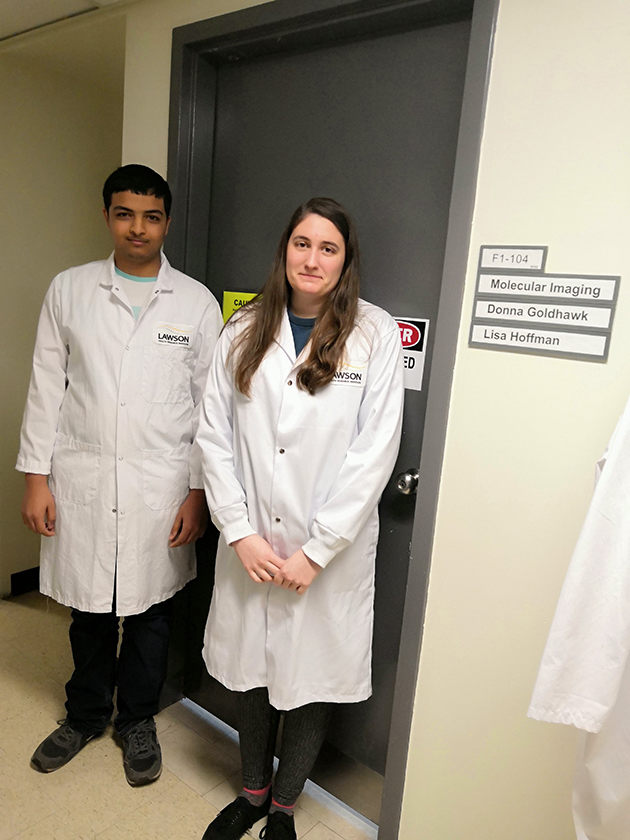

Dr. Donna Goldhawk, an imaging scientist at Lawson Health Research Institute (Lawson), is providing a unique and valuable learning experience to senior high school students. Since 2009, she has accepted students to train in her hospital-based research laboratory at St. Joseph’s Health Care London in partnership with secondary schools in the Thames Valley region.
Dr. Goldhawk recruits students in partnership with the Partners in Experiential Learning (PEL) program. This unique academic co-op education program in London, Ontario identifies high school students interested in health research and prepares them for placement in a health research environment. The students earn senior high school credits and receive training in basic laboratory research.
Originally conceived by Dr. Jim Koropatnick, a cancer scientist at Lawson, and Mr. Rodger Dusky, a retired secondary school teacher, PEL has been running successfully since 2004. It is a partnership between the Thames Valley District School Board, London District Catholic School Board, the Ontario Ministry of Education, Western University, London Health Sciences Centre and St. Joseph’s Health Care London. In Dr. Goldhawk’s experience, PEL attracts an excellent calibre of student who is eager to learn, aspiring to further education and capable of contributing to the science of molecular imaging.
Through the Ontario Research Fund (ORF), the Ministry of Research and Innovation also recognizes the value of attracting youth to the scientific enterprise and provides funding to support youth outreach. Dr. Goldhawk oversees one such initiative, approved under a grant entitled “Heart Failure: Prevention through Early Detection Using New Imaging Methods”. She works with PEL to attract summer students with an interest in molecular imaging.
This year, a total of three ORF summer studentships are available at the following collaborating research labs: Lawson Health Research Institute (London), University of Ottawa Heart Institute (Ottawa) and Sunnybrook Research Institute (Toronto). To learn more about these summer studentships, please email Dr. Goldhawk at @email by May 25, 2018.
Participating students can expect experiential learning tailored to their current understanding of science and aimed at expanding this knowledge for a fuller appreciation of biomedical research.
“ORF youth outreach recognizes the role of medical imaging in today’s workplace and promotes the study of cardiovascular disease in the next generation of researchers,” says Mr. Dusky. “This fills a clear gap in knowledge and career planning for high school youth.”
In Dr. Goldhawk’s laboratory, for example, cardiac research is focussed on the measurement of iron contrast using magnetic resonance imaging (MRI). “Many cells have naturally distinct iron metabolism. However, we are also using genes from magnetic bacteria to improve the magnetic sensitivity of mammalian cells. MRI can then be used to detect disease processes in living subjects.”
“We are particularly interested in reporter gene expression for MRI, a term coined to describe how changes in the pattern of gene activity, and its related protein activity, may be visualized.” Her research group uses laboratory models to track these biological molecules, particularly those involved in cardiac inflammation and cancer growth and metastasis.
Her current team of four graduate and four undergraduate students span various stages of their chosen programs. In this setting, high school students step into a work atmosphere where they interact with colleagues at multiple levels. In addition, since molecular imaging research is inherently interdisciplinary, students acquire training in both biology and physics.
Dr. Goldhawk finds that students exposed to high-quality science education more easily envision themselves in positions of responsibility within the health care sector. Youth learn that developing a scientific career is a process with many choices for fusing interests with a specific occupation.
“To retain the interest of talented young scientists, it is essential to provide them with interesting challenges that reward their curiosity and ambition to learn,” explains Dr. Goldhawk. “In hospital-based research institutes, youth are also exposed to the clinical side for which our research is targeted. This is a quality scientific experience for youth interested in expanding their outlook, performance, technical, problem-solving and record-keeping skills. I think it is essential to build these opportunities into our scientific programs.”

Above: Suhail Shukri, 2018 PEL student at Oakridge Secondary School, and Sarah Donnelly, 2013 PEL student at Wilfred Laurier Secondary School and current MSc candidate at Western University’s Schulich School of Medicine & Dentistry, training with Dr. Jeremy Burton and Dr. Donna Goldhawk at Lawson Health Research Institute.